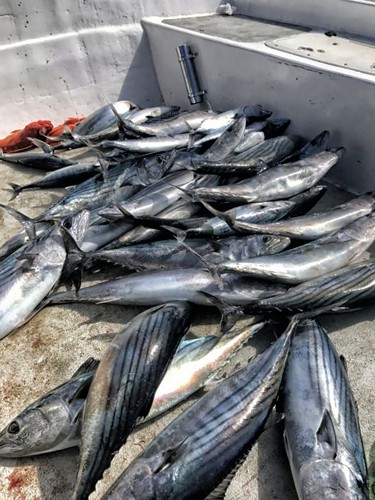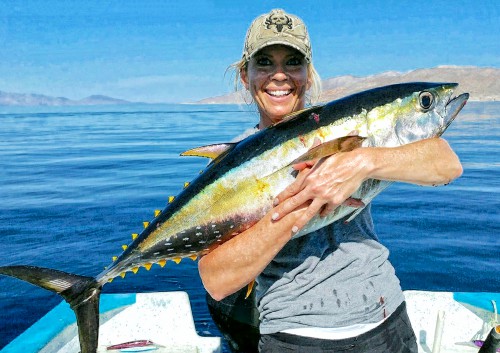 If talk could make fishing good, March would have been off the charts. Thousands of anglers flocked to the Fred Hall Shows in Long Beach, Bakersfield and Del Mar where having a long list of Baja hotels, charter fleets, and guides representing the peninsula from border to tip all under one roof was a special treat for Baja aficionados. This was good timing since March in Baja lived up to its usual reputation of being a grumpy weather month, and discussing the upcoming fishing season and planning for outfitting needs at the shows was almost as good.
If talk could make fishing good, March would have been off the charts. Thousands of anglers flocked to the Fred Hall Shows in Long Beach, Bakersfield and Del Mar where having a long list of Baja hotels, charter fleets, and guides representing the peninsula from border to tip all under one roof was a special treat for Baja aficionados. This was good timing since March in Baja lived up to its usual reputation of being a grumpy weather month, and discussing the upcoming fishing season and planning for outfitting needs at the shows was almost as good.
There were enough clues to convince many that April is full of promise. While Coronado Islands and the west coast, all the way to San Quintín, suffered from “Small Craft Warning” syndrome most of the month, the days it was fishable were consistently good. There were 15- to 25-pound yellows being caught off sonar marks on yo-yo iron and surface iron, as well as on sardines; plus there were enough reds and lingcod down deep to fill in the gaps.

There was more of the same at Ensenada with the addition of some larger variety bonito to fine-tune fish fighting techniques feeding on the surface. When the bait receivers may open is anyone’s guess, so a few packages of fresh or frozen squid isn’t a bad idea.
San Diego sport boats have been pounding the high spots off of Colonet with weather-driven mixed results.

“The girls got it done . . . my wife and daughter-in-law: First stop of the day! Nena is six months pregnant and she’s been roping yellowtail for the last two days. My poor granddaughter is gonna have a gimbal on her forehead…” –Captain Kelly Catain
“Not up to usual standards” is what visitors and locals alike are saying about San Quintín, adding that the yellows are hanging around with the calico bass, and limits of bottom-grabbers is a given.
Cedros Island was well represented at the shows with multiple operations promising another good year as they begin to reopen this spring. This seems to be the story for the entire coast . . . all the way to Magdalena Bay where there are still a few whales left at the entrance. Big yellowtail are being found on the outer banks with a few white seabass mixed in, plus inside the bay fishing is still good with pargo, grouper, and small snook.
Over on the Sea of Cortez side up north from San Felipe, halibut was the prime catch. All the way down the coast to Gonzaga Bay reports include a smattering of small yellows along with good sized grouper, cabrilla, and the ever-present spotted bay bass.

We fished the Northwestern edge of the upper sea of Cortez. One of the best release photos I’ve seen in awhile — directed by Rick Jensen, Cameraman “Rockdyle;” L-R Captain Juan, Pete Gray and Rick Jensen.
(The photo above is an example of using a little creativity while photographing your catch. Thinking outside the box can make a huge difference!)

Back to fishing: Loreto stirring as for the first time in several years — the sardina have returned in large schools and sucked the yellows up from their normal hangouts near the bottom where they usually feed. Everyone is hoping that the return of sardina is an omen and that the dorado will follow in a few months.

“Big smiles from Patricia Trautman from Issaquah, Washington and a nice yellowfin tuna she picked up off the south side of Cerralvo Island early in the week when the seas were flat and the winds had subsided…” -Jonathan Roldan, Tailhunter International
In La Paz they are catching a few tuna . . . not wide open but enough to be encouraging for April. It’s not like the fish are crashing, but considering it is so early in the year, it’s surprising to see tuna around and of this size and quality with fish going 20 to 50 pounds near the south side of Cerralvo Island. There were also a few biters on wahoo.
More common were the types of inshore fish during the winter that included some bonito, snapper, pargo, jack crevalle, sierra, and even a few amberjack and roosterfish, which is a good sign.

At East Cape more of the same as La Paz with a few striped marlin on the La Ribera Bank and a few blue marlin up near Cerralvo. Also along the shore, sierra and ladyfish for fun and an unusually large sheepshead was taken weighing 27 pounds.

Puerto Los Cabos has already had some early wahoo along with the more common this time of year, red snapper, or locally called huachinango; these are the true Pacific red snapper, found over the offshore structure.
At the tip off Cabo San Lucas, billfish action remains inconsistent with only a few here and there; however, much of the inshore action very nicely took up the slack to the delight of visiting anglers, allowing them to pick and choose from a remarkable selection of different species which offered lots of action and strong fights, along with some fish that are always welcome guests at the dinner table.

Sierra mackerel, red snapper, grouper, amberjack, and yellowtail certainly qualified in both the “tough fighting” and “good eating” categories. Added to the mix were the roosterfish, ladyfish, skipjack, and jack crevalle . . . all considered a challenge on light tackle.
It would appear the bite overall is improving, particularly in Baja Sur as spring settles in, which means it is a good time to check your tackle before an early season sneaks up on you.
Questions or comments are welcome. garyg@garycgraham.com
 With more than five decades of fishing experience – from light tackle and fly to offshore billfish – Gary Graham has experienced all aspects of fishing in the Southern California and Baja waters. His observations of species behavior, tackle and techniques are always from his unique perspective, earning him the respect of his peers as well as anglers who eagerly follow his Baja reports and features.
With more than five decades of fishing experience – from light tackle and fly to offshore billfish – Gary Graham has experienced all aspects of fishing in the Southern California and Baja waters. His observations of species behavior, tackle and techniques are always from his unique perspective, earning him the respect of his peers as well as anglers who eagerly follow his Baja reports and features.
Gary maintained a home at East Cape in Baja Sur for more than 18 years and still spends nearly half of each year exploring the entire peninsula in his self-contained Roadtrek van. He observes everything Baja, from the mysteries of a tide pool on a deserted Baja beach filled with tiny sea creatures to the largest billfish in the sea.
